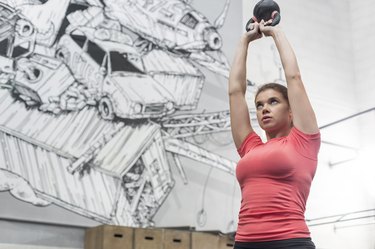
Ballistic training is commonly used by athletes to develop explosiveness and power. By accelerating and releasing weight into free space, the athlete's body recruits fast-twitch muscle fibers, which are directly responsible for growth and strength. Ballistic movements require the central nervous system to coordinate and produce the greatest amount of force in the shortest amount of time.
Jump Squats
Video of the Day
Jump squats build strength, speed and power and improve your rate of force development. The high speed movement will fire up your nervous system, increasing neural output and muscle recruitment. To perform a jump squat, start in the correct squat position and jump vertically off the floor, returning to the starting position in a controlled manner. These can also be used at the beginning of a leg workout to enhance further strength work.
Video of the Day
Push Presses
A push press is similar to a military press, except that the movement begins in the legs. Start in a standing position with the bar at collar bone height supported in your hands. Do a quarter squat, dipping quickly, then explode to full hip extension. As you begin to finish the leg drive, focus on pressing the bar up like a shoulder press. Once the bar gets past your forehead, lock the bar out completely overhead. All joints from the floor to the wrists should be completely in line, with the weight locked out overhead.
Kettlebells
Kettlebell exercises build strength and endurance, improve cardio, and increase grip strength. The basic movements, such as the swing, snatch, and the clean and jerk, engage the entire body at once. Many traditional ballistic exercises can be performed with kettlebells in addition to kettlebell specific movements, such as the swing.
Tips to Remember
Before incorporating ballistic movements to your workouts, it's best to build strength with closed chain movements. Perfect your form and technique before progressing into more advanced positions or loading exercises with weight. Work with a trainer or an experienced spotter to ensure correct execution of each exercise. If for any reason you experience any pain, immediately discontinue the exercise and seek appropriate medical attention.
- "NSCA's Performance Training Journal"; Overview of Power Training; Paul Fleschler CSCS; June 2002
- "Journal of Strength and Conditioning", Comparison of Loaded and Unloaded Jump Squat Training on Strength and Power Performance in College Football Players; J.R. Hoffman, et al.; November 2005
- "NSCA’s Performance Training Journal "; Practical Progressions for Upper Body Plyometric Training; Mark Nutting, CSCS, NSCA-CPT